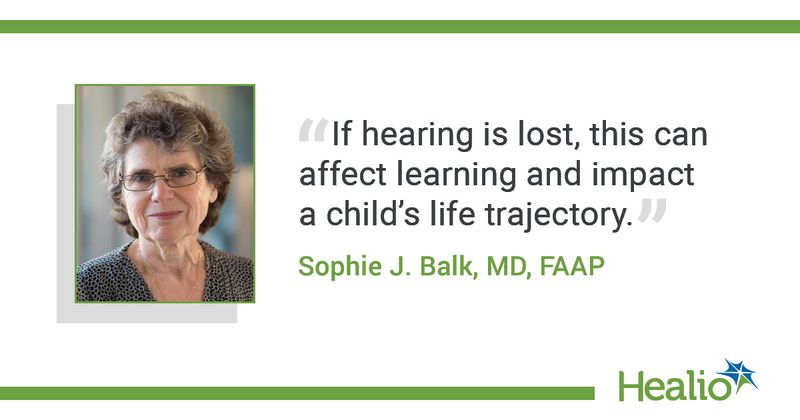Q&A: How children could lose hearing due to loud noises
Key takeaways:
- Hearing loss from noise is permanent and cannot be restored with medical treatment.
- Infants are exposed to excessive noise at concerts, sports events, fireworks displays and celebratory events.
WASHINGTON — In a new policy statement and technical report, the AAP raised an alarm over excessive noise exposures in childhood and explained how it can lead to hearing loss over time.
“Pediatricians can potentially lessen harms by raising awareness of children’s specific vulnerabilities to noise. Safer listening is possible,” Sophie J. Balk, MD, FAAP, a professor of pediatrics at the Albert Einstein College of Medicine in the Bronx, and colleagues wrote in Pediatrics. “Noise exposure is underrecognized as a serious public health issue in the United States. Greater awareness of noise hazards is needed at a societal level.”

We spoke with Balk, a member of the AAP Council on Environmental Health and Climate Change Executive Committee, who copresented the technical report and policy statement at the AAP National Conference & Exhibition.
Healio: What types of potential harmful noises are children exposed to in infancy, and what kind of an effect can it have on their hearing in the long term?
Balk: Excessive noise exposure can damage the delicate structures of the inner ear, resulting in hearing loss. Once hearing is damaged by noise, the hearing loss is permanent and cannot be restored with medical treatment.
Children, including infants, are considered vulnerable to excessive noise for many reasons. Immature organ systems such as the auditory system are rapidly growing and developing. This often makes them more susceptible to the effects of noise and other environmental hazards compared with mature systems, illustrating the concept of “critical periods of vulnerability.” Young children’s external ear anatomy is different from adults’, resulting in intensification of higher frequency sounds. Infants and young children have less control over their environments compared with adults and older children and must rely on others to remove them from hazardous situations. Children have long life spans, allowing for repeated and cumulative noise exposures. If hearing is lost, this can affect learning and impact a child’s life trajectory.
Infants can be exposed to excessive noise if they are taken into very loud situations such as concerts, sports events, fireworks displays and celebratory events. They can be exposed to potentially harmful sound through sleep — “white noise” — machines. Some of these machines can generate loud noise that could harm hearing. Some toys can emit sounds loud enough to potentially affect hearing.
We are very concerned about personal listening devices such as headphones and earbuds. WHO estimates that almost 50% of people aged 12 to 35 years — 1.1 billion young people — risk losing hearing because of prolonged and excessive exposure to loud sounds from their personal devices and attending loud venues and events. Even young children risk hearing loss from their devices. This is a key area for clinicians to discuss with parents and teens.
We are also concerned about the nonauditory effects of environmental noise. Environmental noise — also known as “noise pollution” — comes mainly from sources such as traffic, railways, airplanes and airports. Environmental noise usually does not affect hearing but has other adverse effects. Environmental noise causes a physiologic stress response. It can affect sleep and causes annoyance. Children exposed to environmental noise have more difficulties with learning. There is a disparities issue because children in minority and underserved areas are more likely to be exposed to environmental noise.
Healio: How can parents prevent excessive exposure to these types of noises?
Balk: Noise has been underrecognized as a critical health hazard, and we all need to become more aware of noise hazards to children. Early life exposures to excessive noise can result in hearing loss at young ages and are also likely to contribute to adult hearing loss.
Parents can make sure their baby has hearing protection such as protective earmuffs when attending noisy events such as sporting events or fireworks displays. Even young infants can wear earmuffs. They can also choose to avoid or leave these hazardous situations. They can use a sound meter app to measure the noise level at an event, but in general, if it sounds too loud for a parent, it most likely is too loud for an infant. If infant sleep machines are used, it is prudent to locate them as far away as possible from the infant, set the volume as low as possible and limit duration of use. Parents can consider noise when buying toys and avoid noisy toys.
Healio: How do you recommend providers discuss noise exposure with parents?
Balk: If they aren’t already doing so, we recommend that pediatricians and other pediatric clinicians add hearing health to their agendas. Noise-induced hearing loss is entirely preventable. Just as we encourage parents and teens to think about protecting their skin from the sun when they go outside, we would like everyone to consider how to protect their ears when they listen to music or go to a noisy event.
References:
- American Academy of Pediatrics sounds the alarm on excessive noise and risks to children’s hearing in updated policy statement. https://www.eurekalert.org/news-releases/1004607?. Published Oct. 20, 2023. Accessed Oct. 20, 2023.
- Balk SJ, et al. Pediatrics. 2023;doi: 1542/peds.2023-063752.
- Balk SJ, et al. Pediatrics. 2023;doi: 1542/peds.2023-063753.

